Link-building reporting might sound simple. You send a list of backlinks built, and the job is done, right?
Well, it might work for a small website.
But it won’t work for an enterprise client. Or a fast-growing SaaS startup. Or a law firm.
Trust me, I’ve tried it.
The report must demonstrate the value you deliver. And this means something different for every client.
That’s why, at Editorial.Link, we build tailored reports for every client. And different ones yet for internal use.
And in this guide, I’ll show you what exactly you should include in your backlink report.
Why Link Building Reporting is Important?
Link-building reporting helps clients assess the effectiveness of your link-building efforts and understand the impact of the links you build for them. The ROI.
This goes beyond listing raw data. Clients can look it up themselves.
It’s about presenting it in a digestible way and providing context, so they can clearly see where their money goes and how it helps their business grow.
Internal link building reports help teams optimize their performance and deliver better service to clients.
15 Data Points to Include in Your Link Building Reports
Let’s look at the core things your report needs to show. Divided into three sections:
- Link acquisition and backlink profile report
- Outcomes report
- Operations and finance report
Link acquisition and backlink profile report
Let’s start with the metrics that directly show the effectiveness of your link-building campaigns.
1. Number of new referring domains and backlinks
Our reports start with the basics: how many new backlinks we built in the period.
But we don’t stop at raw counts. We pair backlink totals with the number of new referring domains.
To give a clearer picture of link diversity.
Because a hundred links from one site won’t carry the same weight as a hundred links across unique domains.
💡Pro tip: Add a screenshot from Ahrefs or Semrush to make the data visual and easy to verify. This reassures clients that numbers are backed by trusted third‑party tools.

🔍 Agency insight: According to our article about "how many backlinks do your need", you needed 300–500 high‑quality backlinks to rank in a competitive niche in 2024. In 2025, this is closer to 300–700.
2. Link velocity
Link velocity shows how quickly you’re gaining backlinks over time. Or losing them.
A steady upward trend demonstrates consistency and lowers the risk of looking manipulative to search engines.
Sudden spikes, on the other hand, can raise red flags.
When reporting, include a simple month‑over‑month chart that highlights both the number of new links and referring domains gained.
This makes it easy for clients to see momentum at a glance.
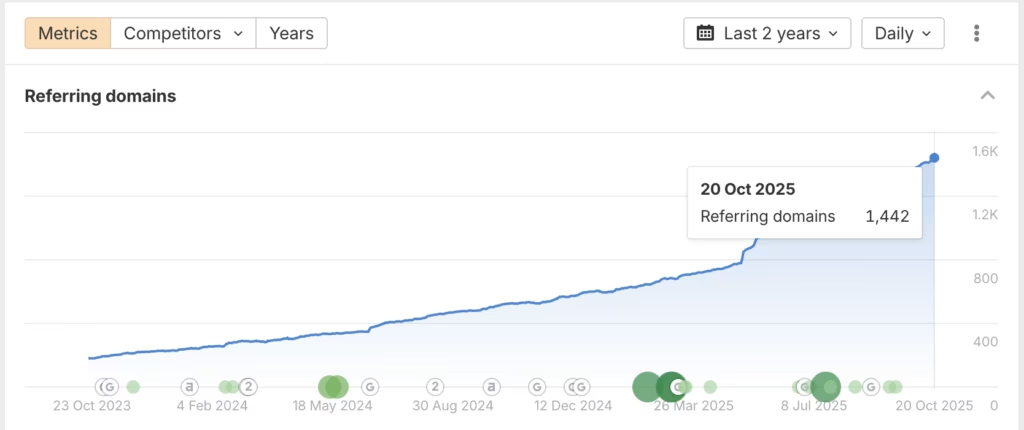
💡Pro tip: Explain what the data means in context. For example, highlight if the velocity aligns with competitors, or if extra effort is needed to close the gap.
3. Lost links and reclamation efforts
Show clients exactly which links were lost, why it happened, and — if you built them — what steps you took to reclaim or replace them.
Backlinks naturally drop off. Pages get deleted or links are removed.
For a customer, it may look like you’re just not doing your work.
So, reporting on lost links builds trust and preempts clients’ concerns.
🏆 Winning practice: At Editorial.Link, we offer a link replacement guarantee. If our backlink disappears, we replace it so you don’t lose momentum (and money, of course).
4. Anchor texts
Our link-building reports always show anchor text distribution: how many of them are partial-match, how many are exact-match, and how many are branded.
Because how your backlinks are embedded in the text often influences how well a page ranks. And it directly affects topical relevance.
A healthy backlink profile has a mix of anchor texts (as shown in our study).
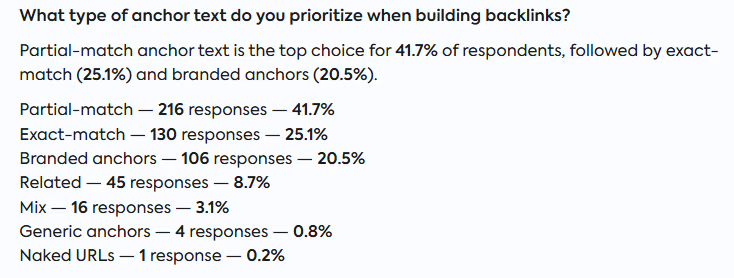
Overoptimized profiles, on the other hand, with too many exact-match or branded anchors, can look manipulative.
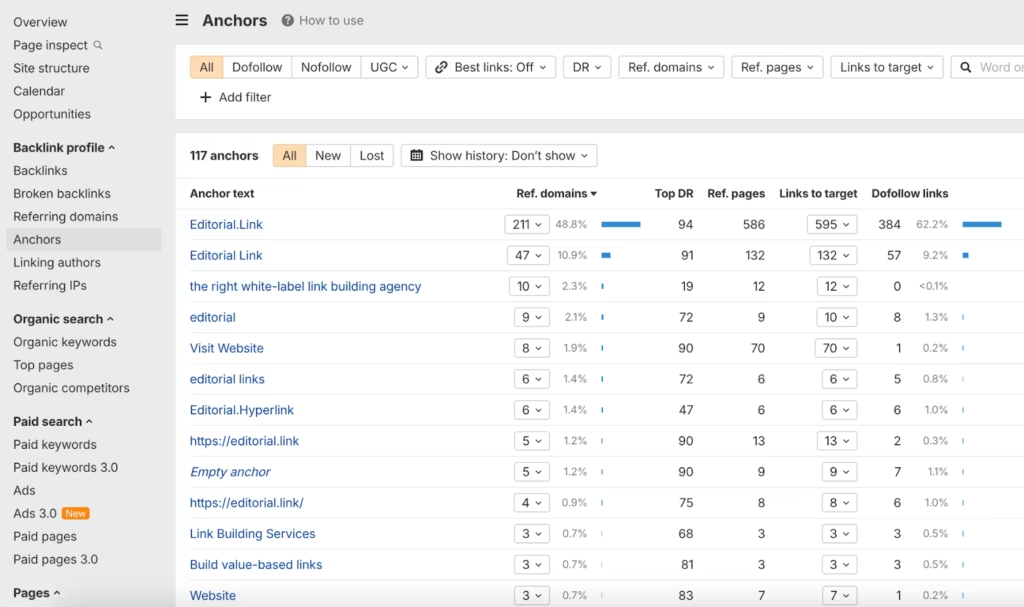
5. Link quality signals
When reporting on the links you’ve built, share data about their quality:
- Domain Rating (DR): Higher DR sites tend to pass more authority.
- Traffic: Links from sites with real, steady traffic are more valuable than those with no visitors.
- Topical relevance: A link from a niche-relevant site reinforces topical authority.
- Page type: In-content links on editorial pages carry more weight than links in footers, sidebars, or author bios.
🏆 Winning practice: Our clients get a chance to pre-approve the websites before we secure the backlinks on them, so there are no surprises when they receive the report. The average DR of our links is 67, and all are placed in relevant content to ensure maximum impact.
6. Toxic/Bad backlinks
We monitor toxic backlinks in every report — along with a quick explanation of why it’s worth keeping an eye on them.
“But Google ignores bad backlinks!” or “Low-quality links won’t hurt you!” I hear you say.
And it’s true. Google algos are much better at discounting spammy links, and we wouldn’t disavow any suspicious links right away (especially, as the effectiveness of disavowing is debatable and it can even hurt performance).
But spam attacks still happen. And we’d rather be safe than sorry.
Plus, it builds clients’ trust.
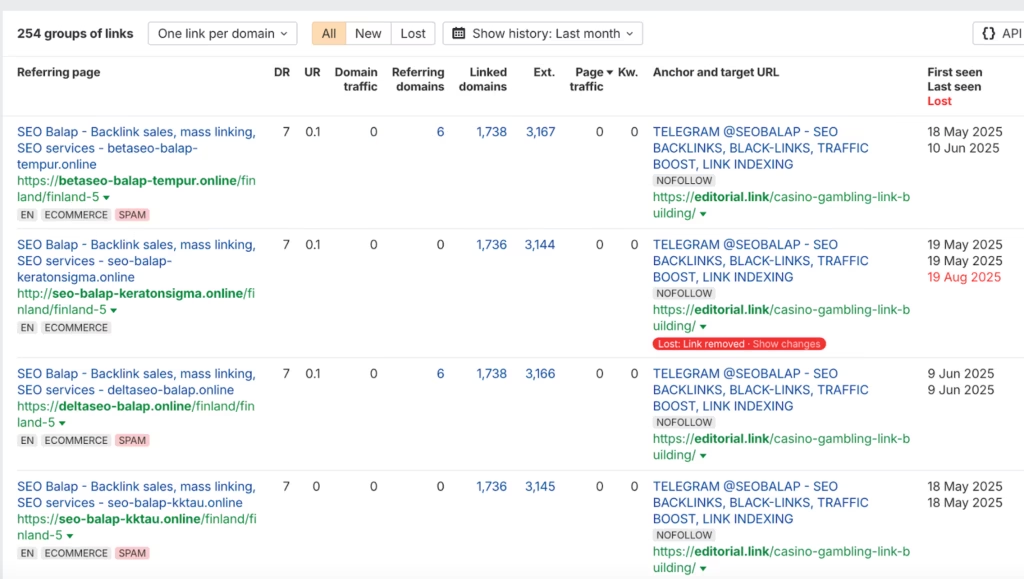
7. Link attributes
Every report should break down how many links are dofollow, nofollow, UGC, or sponsored.
A rule of thumb: we want around 70-80% of the backlinks to be dofollow as they have the biggest impact on SEO performance.
Having said that, the distinction is getting less significant.
There’s evidence that nofollow backlinks do move the needle in organic search, and LLMs don’t discriminate between brand mentions that come with any of the attributes.
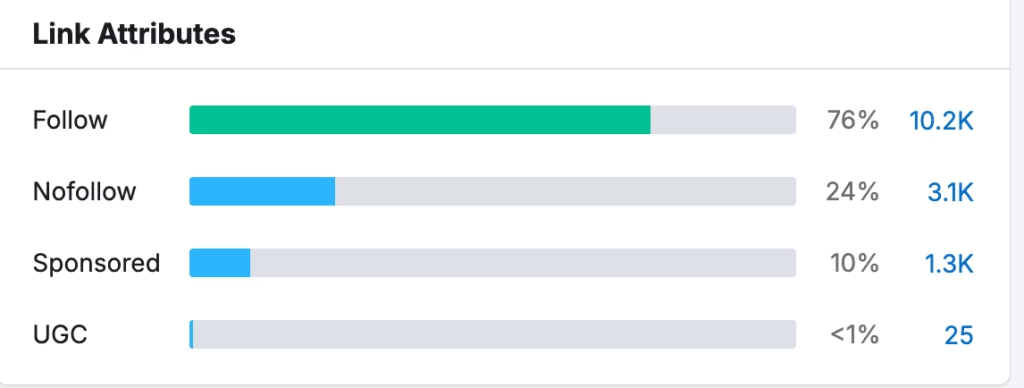
8. Top pages by backlinks
Pages that are getting the most backlinks are another key aspect to highlight in your report.
Here’s why:
Seeing where the links are landing helps you focus your link-building campaign.
Is the page already strong? Shift your efforts to an underperforming one.
And if the client knows which pages are attracting backlinks naturally, they can amplify their results by creating more of such link-worthy content.
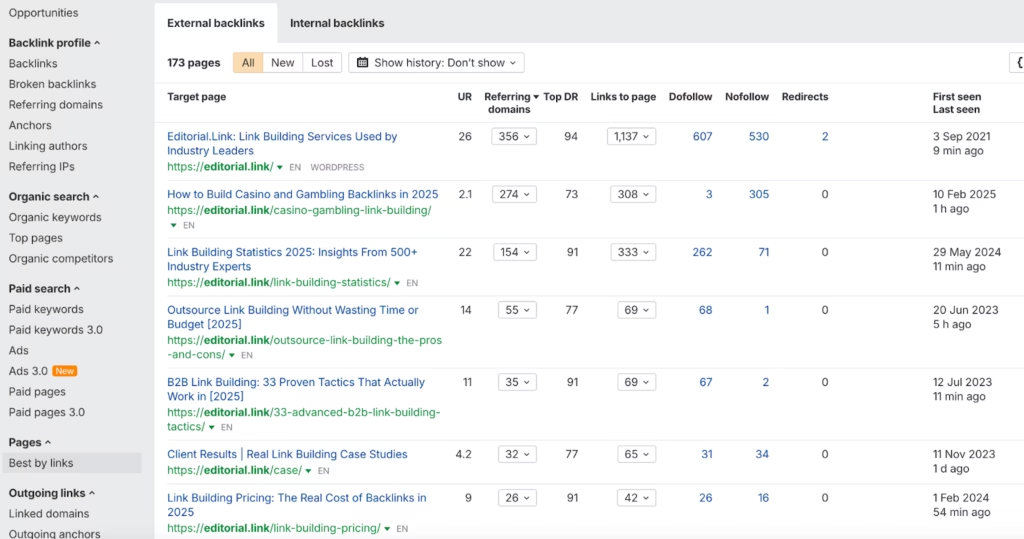
📊 Data spotlight: According to our survey data, SEOs see service/product pages as the most important for getting links (52.7%), followed by blog posts/articles (38.4%), the homepage (7.1%), and other pages (1.7%).
9. Inbound vs. outbound link ratio
We report not only on the inbound links but also the outbound ones.
Specifically, the inbound-to-outbound ratio.
While there’s no fixed figure to aim for, we want clients’ backlink profiles to have more inbound links than outbound ones.
The reason? Lots of outbound links and few inbound ones may look like a link farm.
Which isn’t great for rankings. And it puts off potential partners, making link acquisition difficult.
On the flipside, we need outbound links to add value for readers and help with page discovery.
Outcomes Report
A backlink count on its own is a vanity metric. Ultimately, it’s all about their impact — on rankings, AI search visibility, and traffic.
10. Target keyword and page rankings
Every solid report should show how backlinks improve the target keyword and page rankings.
Here’s how to do it:
- Track the specific keywords you’re actively building links for.
- Highlight position changes over the reporting period (wins and drops).
- Pair rankings with link data to show correlation (causation is difficult to prove)
11. Organic traffic
Higher rankings mean higher traffic, and we always include it in our reports.
Because traffic drives growth: More traffic → More leads → More revenue.
In your report:
- Highlight traffic trends for the client’s site over the reporting period.
- Correlate traffic growth with link-building efforts to demonstrate their impact.
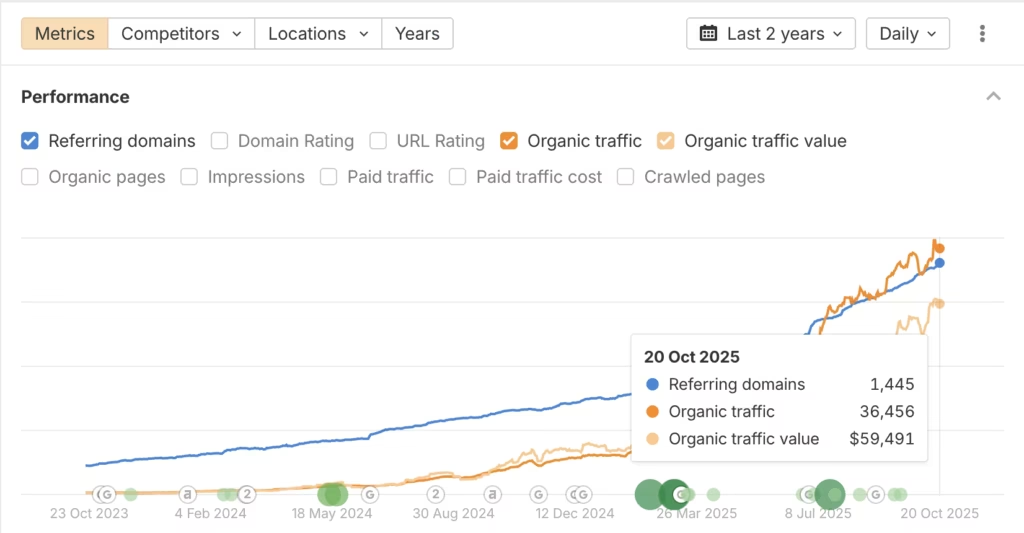
12. Referral traffic from backlinks
Showing referral traffic in your report proves the links are delivering value beyond rankings.
For example, a backlink we secured on NeilPatel.com brought a fair number of highly engaged visitors to our site.

In your referral traffic report:
- Highlight which backlinks sent the most traffic during the reporting period.
- Show bounce rate and conversions from that traffic if available — to make the case stronger.
- Explain the context. For example, what kind of placement or content type brought the results.
13. AI search visibility
AI search visibility is a new aspect that we reflect in our reports.
While organic search is still the key focus, clients are increasingly more concerned about getting cited in AI Overviews or ChatGPT/Perplexity answers.
The AI rank tracking tools are still in their early days, but you can easily demonstrate the effectiveness of your efforts by sharing screenshots along with the cited sources, like below.
And yes, we got listed in all three articles.
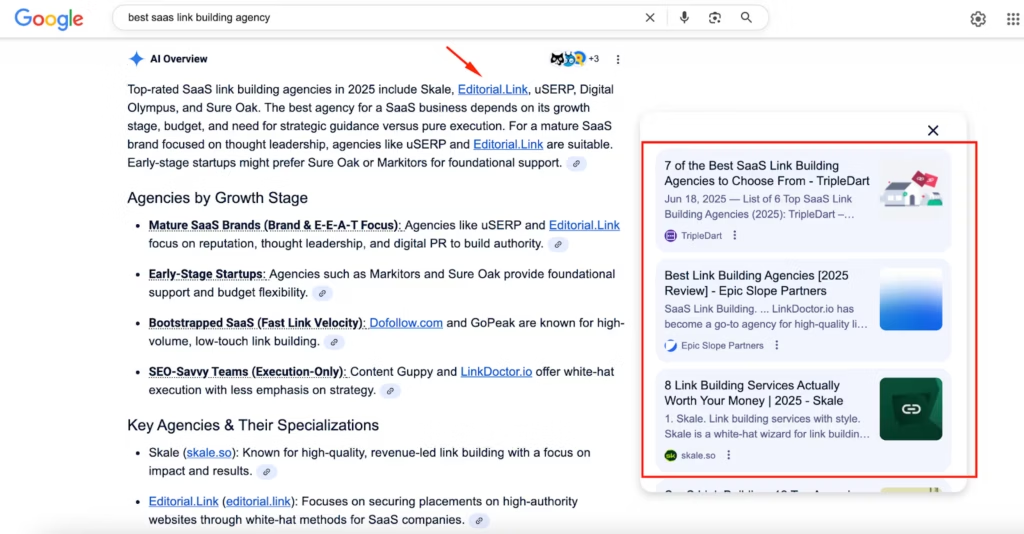
Operations and Finance Report
Financial transparency builds customer trust. When combined with pipeline and outreach performance data, it allows teams to optimize their processes.
14. Link pricing and budget transparency
Link prices and budget utilization summary are mandatory sections in each link-building report.
Showing how you use clients’ money builds trust and prevents tough questions later.
If you charge per link, like us, that’s fairly easy: List the links provided and issue the invoice.
It gets more challenging with retainer-based pricing, and even more so when you charge per hour or outsource some of the work. The tools, the cost of content creation, the time spent on outreach.
But the more complex your billing structure is, the more important money transparency is.
15. Pipeline and outreach performance
Reporting on outreach performance and current pipeline state may not matter for your clients, but it definitely does for your team. And their ability to deliver on their commitments.
What should you include in the report? At the very least:
- Emails sent, emails opened + open rate, replies received + response rate, and templates that deliver the best results.
- Links under negotiation, links awaiting publication, and links already secured.
Create Clear Link-Building Reports to Demonstrate ROI to Clients
Strong link-building reports connect the dots between strategy, execution, and results. That’s what earns trust and keeps clients invested.
By covering acquisition, quality, outcomes, and finances, you give a full picture of the investment and its returns. If you want high-quality editorial backlinks backed by transparent reporting, try Editorial.Link.

